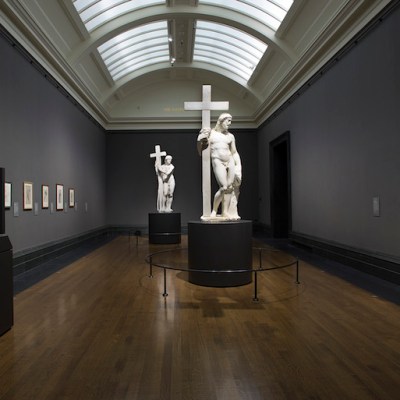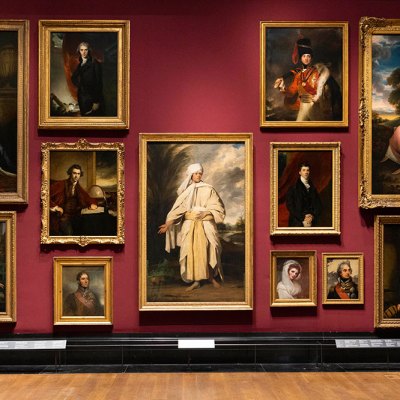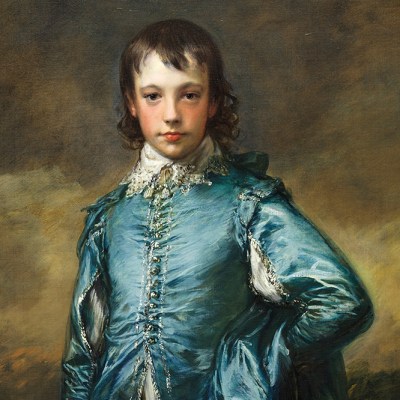From the May 2024 issue of Apollo. Preview and subscribe here.
The Sebastiano del Piombo is mine!!!’ crowed the novelist and art collector William Beckford in May 1823. Originally commissioned by Cardinal Giulio de’ Medici and standing at nearly four metres high, Sebastiano’s The Raising of Lazarus (1517–19) was one of 19th-century London’s most celebrated pictures; a coup even for Beckford, the voracious proprietor of Fonthill Abbey. In the painting, a crowd gesticulates in amazement as Lazarus unfurls himself from his winding sheet, at the command of a classically dressed Christ. Michelangelo is thought to have helped Sebastiano with the figures, knowing that the painting was intended to vie with the Transfiguration (1516–20) of his young rival, Raphael, in Narbonne Cathedral.
Since 1798, The Raising of Lazarus had hung in the London drawing room of the businessman John Julius Angerstein, who died in January 1823. Beckford made his trustees a liberal offer, but his jubilation was premature. In April 1824, The Raising of Lazarus was purchased, along with 37 other paintings from Angerstein’s collection – as well as his town house at 100 Pall Mall, where they were displayed – by Lord Liverpool’s government, for ‘the foundation for a National Gallery of works of art’.
The Raising of Lazarus (c. 1517–19), Sebastiano del Piombo, incorporating designs by Michelangelo. National Gallery, London

Sebastiano’s celebrity has dwindled since 1824 and Angerstein’s name may not hover on the lips of many 21st-century visitors, but The Raising of Lazarus still bears the honorific inventory number ‘NG1’ in the modern National Gallery, which celebrates its bicentenary this year. The gallery moved out of Angerstein’s house and into William Wilkins’s purpose-made building in 1838, but Angerstein and his collection continue to inflect the shape and character of its holdings. Excepting Russia, Britain was the last major European nation to establish a gallery – ‘to give,’ (as Liverpool declared in the House of Commons) ‘a munificent encouragement to the support and promotion of the Fine Arts’.
Britain was also unusual in purchasing its collection readymade, rather than turning a princely gallery or royal collection over to the state (as had happened in France and across much of 18th-century Germany). The Angerstein collection, whose contents were enticingly outlined for prospective buyers in an illustrated presentation catalogue authored by John Young, Keeper of the British Institution, was small, and its origins less than august. However, it was also a product of the specific collecting conditions of the late 18th century and a remarkably focused example of the period’s accepted art historical canon. As such, its acquisition was a statement of intent about the purpose of the new project.
‘This is not a bazaar, a raree-show of art, a Noah’s ark of all the Schools, marching out in endless procession,’ William Hazlitt wrote, ‘but a sanctuary, a holy of holies, collected by taste, sacred to fame.’ Young was pithier: Angerstein’s collection included ‘only the finest works of the greatest masters, to the entire exclusion of every inferior production’. Almost half the total works acquired by the nation were Italian; 25 were dateable to within the period 1600–50. In addition to Sebastiano, there were paintings by Titian, Raphael, Correggio, the Carraccis and Domenichino. Angerstein had also owned three Van Dycks, three Rembrandts (two since downgraded to a pupil) and five Claudes (‘Mon dieu! Such Claudes!’ exclaimed Charles Lamb).
The National Gallery’s holdings have since expanded in scope, with acquisitions such as the Robert Peel collection, which brought 68 Dutch and Flemish works into the collection in 1871. Even so, at just over 2,300 paintings, it retains the comparatively small size and tight focus it inherited from Angerstein, and Young’s voice echoes in its current self-identification as a collection showing ‘the story of European art, masterpiece by masterpiece’.
Part of the gallery’s original collection can be seen in Frederick Mackenzie’s watercolour view of The National Gallery, when at Mr. J.J. Angerstein’s House, Pall Mall (exhibited 1834), which gives an elegant gloss on what a contemporary described as a ‘small dingy house on the south side of Pall Mall’. It is busy – the new gallery received 24,000 visitors in its first seven months – and, as early advocates for a National Gallery had hoped, artists are busy copying the masters. Sebastiano dominates the main wall, but he still vies with Raphael, whose Pope Julius II (1511) is in the back room. Also prominent are three of Angerstein’s Claudes – Seaport with the Embarkation of Saint Ursula (1641), Landscape with Cephalus and Procris Reunited by Diana (1645) and A Seaport (1644) – and Aelbert Cuyp’s Hilly Landscape with Figures (1655–60).
The National Gallery, when at Mr. J.J. Angerstein’s House, Pall Mall (1824–34), Frederick Mackenzie. Victoria and Albert Museum, London.

Mackenzie’s watercolour also shows several of the paintings the nation had acquired in the intervening decade, most of which continued the original focus on continental Old Masters: Titian’s Bacchus and Ariadne (1520–23, bought in 1826 from the goldsmith Thomas Hamlet); Correggio’s Ecce Homo (1525–30), purchased from the Marquess of Londonderry in 1834, and Tintoretto’s Saint George and the Dragon (c. 1555), one of 32 paintings bequeathed in 1831 by the clergyman art collector William Holwell Carr, on the proviso they be hung with Angerstein’s. Carr’s was not the only donation made with explicit reference to the original collection: in 1822, Sir George Beaumont, the British Institution’s founding director, made the gift of his own pictures, including three further Claudes, dependent on the nation’s acquisition of the collection at Pall Mall.
A certain mystique had always hung about Angerstein. Born in St Petersburg in 1735, he had come to London in his teens and was popularly (and impossibly) rumoured to be the natural son of Catherine the Great (b. 1729). From working in the counting house of Andrew Poulett Thomson (a more probable parent), he established himself as broker and underwriter at Lloyd’s of London, newly expanded from its beginnings in a coffee house in Tower Street to a professionalised outfit synonymous with marine insurance.
The standardisation and formalisation of financial coverage for ships – most importantly through the ‘Register of Ships’ which Lloyd’s established in the 1760s – were key factors in the enormous expansion of British overseas trade, including the slave trade, during this period. Angerstein’s business activities therefore put him at the forefront of national and international affairs. He was a government shipbroker during the American War of Independence, became chairman of Lloyd’s in 1790 and supplied ships and insurance to the British government throughout the Napoleonic Wars.
His fabulous wealth contrasted with Angerstein’s personally unassuming habits: Joseph Farington, who described his clothes as ‘plain, but respectable’, remembered him dozing on and off after dinner, beneath his enormous Sebastiano. ‘After he awoke,’ he recalled, ‘he ate an orange with sugar.’ Nonetheless, he spent liberally on art. He was reported to have paid 3,500 guineas for the Sebastiano, 8,000 for two Claudes and (it was rumoured) 4,000 pounds for Rembrandt’s The Woman Taken in Adultery (1644). He also made full use of his collection’s social and philanthropic potential, lending to public exhibitions at the British Institution and making his Pall Mall home available to artists and a limited public, possibly from as early as 1800.
Angerstein’s relationship with the art establishment went both ways. Although the anonymous author of an obituary in the Annual Biography and Obituary for 1824 was keen to stress that he had copious ‘natural taste’, he was generally agreed to have lacked ‘those opportunities of observation and comparison which alone could have secured him from occasional imposition’. His collection was therefore formed partly under advice, notably that of Thomas Lawrence, a personal friend who also happened to be president of the Royal Academy, and whose involvement therefore added establishment grandeur to the nation’s acquisition.
Angerstein can be seen at the age of 30, in 17th-century dress, as painted by Lawrence’s predecessor, Joshua Reynolds. ‘Van Dyck’ costume was a fashionable reference point for mid 18th-century aesthetes and aristocrats, but Angerstein’s black and white clothing and easy confidence are more specifically reminiscent of Van Dyck’s portrait of George Gage (one of the most significant art brokers for Charles I), which Angerstein would purchase from the sale of Reynolds’s own collection in 1795. Van Dyck’s gentleman-buyer (believed in the 18th century to be Rubens) lolls over a classical pedestal with a studied nonchalance that belies his intense concentration on the antiquity offered up to him.
John Julius Angerstein (1765), Joshua Reynolds. Saint Louis Art Museum
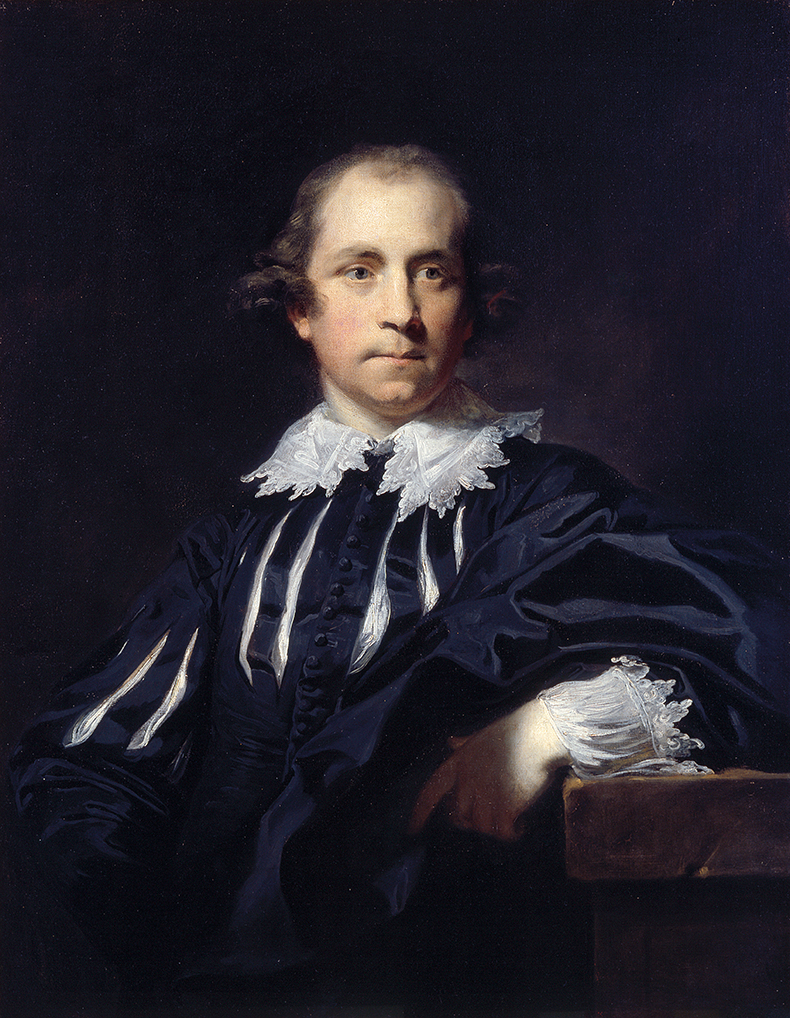
Now in the National Gallery, the painting represents the art market as a matter of shrewd business dealings as much as aesthetic interest, a perspective with which Angerstein must have been familiar. He profited both professionally and artistically from the international upheavals of the century’s end, success in the one facilitating success in the other. The Raising of Lazarus, along with two Correggios and two Carraccis, came from the famed Orléans collection, sold by Louis Philippe d’Orléans (‘Philippe Égalité’) in 1792 after the French Revolution. The so-called Bouillon Claudes – Seaport with the Embarkation of the Queen of Sheba and Landscape with the Marriage of Isaac and Rebecca, both painted in 1648 for Frédéric Maurice, duc de Bouillon – were purchased from the dispersed collection of the duc de Praslin.
The glittering provenances of these pictures and the vast sums involved, particularly during a period of conflict with France, gave a patriotic glow to Angerstein’s collection which neatly carried over to the National Gallery itself. ‘Not the luxuriant crown of victory […] can reflect more lustre on the name of a Nelson or a Wellington, than does the enviable laurel wreath […] that must ever illumine the name of Angerstein,’ wrote Charles Westmacott. While Westmacott linked art collecting with martial victory, The Gentleman’s Magazine noted with approval that in Angerstein, ‘the character of a British merchant was developed in the most honourable manner; for as his wealth was drawn from trade, so was it freely expended in the protection and encouragement of the arts’. For Samuel Jackson Pratt, meanwhile, Angerstein was a personification of the ‘National Picture – an ENGLISH MERCHANT’; he combined ‘the purest commercial integrity with the most extensive active benevolence’, having ‘secured to this Country a domestic treasure’ in the shape of his collection.
The union of art and commerce made the National Gallery distinctively mercantile in origin, a point that was underlined in Liverpool’s 1824 budget statement announcing the allocation of £57,000 for the new gallery. With an implicit swipe at the contents of the Louvre, where a pre-existing royal collection had been liberally supplemented by the rapacious hand of Napoleon, Liverpool asserted that every Englishman who entered the new gallery ‘may gaze with proud satisfaction of reflecting that they are not the rifled treasures of plundered palaces, or the unhallowed spoils of violated altars’, but rather the trophies of honest trade. (This assertion has not aged well; it was the same Lord Liverpool whose government had authorised the purchase of the Parthenon Marbles.)
Even so, the image of Angerstein as the nation’s well-advised collector-benefactor is somewhat at odds with the foreignness of what he owned. Responding to talk of the proposed gallery, and with some irony given his own provenance in Springfield, Pennsylvania, the artist Benjamin West had opined that ‘a collection including foreign pictures could not be “national”’. Indeed, while the Anglo-French hostilities of the 1790s made it possible for deep-pocketed British buyers to buy continental Old Masters in bulk, others considered a more appropriate act of patriotism to be the acquisition of art by Britons.
The most famous example is the amateur artist and politician John Fleming Leicester, who assembled more than 100 British pictures and displayed them (in part) in a purpose-built, top-lit neoclassical gallery at his home in Hill Street, Berkeley Square. Like 100 Pall Mall, this was open to a select public, and the patriotism of Leicester’s activities prompted another comparison with Wellington, this time from the editor of the Literary Gazette, William Paulet Carey, who connected Leicester’s collecting with the ‘unparalleled career of the greatest Commander of the age’. However, when in May 1823 Leicester offered his own ‘gallery’ to the nation for ‘a National Gallery for British Art’, Liverpool rejected the offer out of hand, writing that ‘the old Masters must find a place’ in a national gallery.
Marriage A-la-Mode: 2, The Tête à Tête (c. 1743), William Hogarth. National Gallery, London
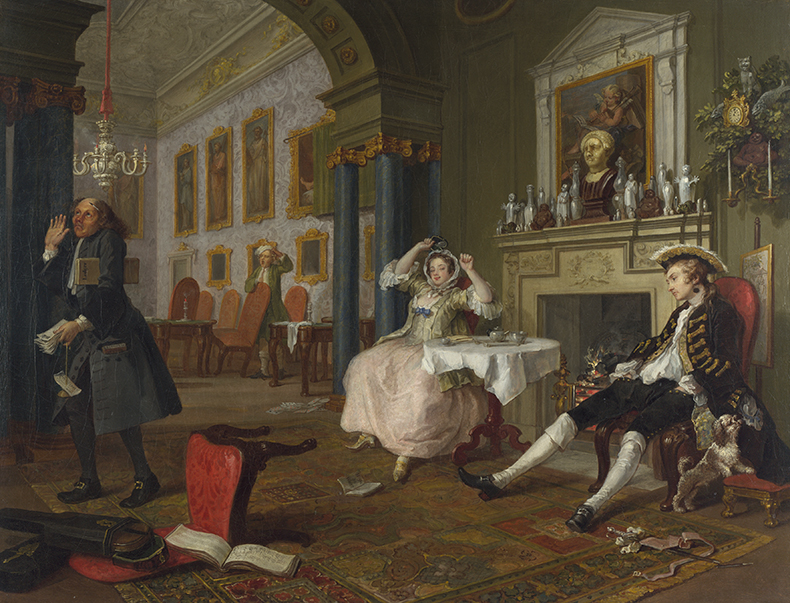
In truth, this was not a straightforward either/or: though Angerstein’s collection was celebrated for the kind of large-scale Old Masters Liverpool was angling for, it did include significant paintings by British artists, most famously the six paintings of Hogarth’s Marriage A-la-Mode (1743–45), purchased from the publisher John Boydell and hung with Angerstein’s other British paintings in the downstairs dining room at Pall Mall (and hence absent from Mackenzie’s watercolour). These, along with Hogarth’s The Painter and his Pug (1745) and David Wilkie’s The Village Holiday (1809–11), were included in the nation’s purchase; the latter two being transferred in 1897, with the majority of the gallery’s British pictures, to the National Gallery of British Art (later renamed the Tate, but formally established as a separate institution in 1954).
For Young, Angerstein’s British pictures were burnished by association with Angerstein’s Old Masters. The juxtaposition would, he felt, bring the British public a sense of ‘just pride and satisfaction’, which would have been impossible in a gallery devoted solely to British art. Even so, many of Angerstein’s other British works weren’t acquired by the nation, including Reynolds’s celebrated David Garrick Between Tragedy and Comedy (1761, now at Waddesdon Manor) and three large paintings by Henry Fuseli, on subjects from Paradise Lost.
A Seaport (1644), Claude Lorrain. National Gallery, London

Sun rising through Vapour: Fishermen cleaning and selling Fish (before 1807), J.M.W. Turner. National Gallery, London
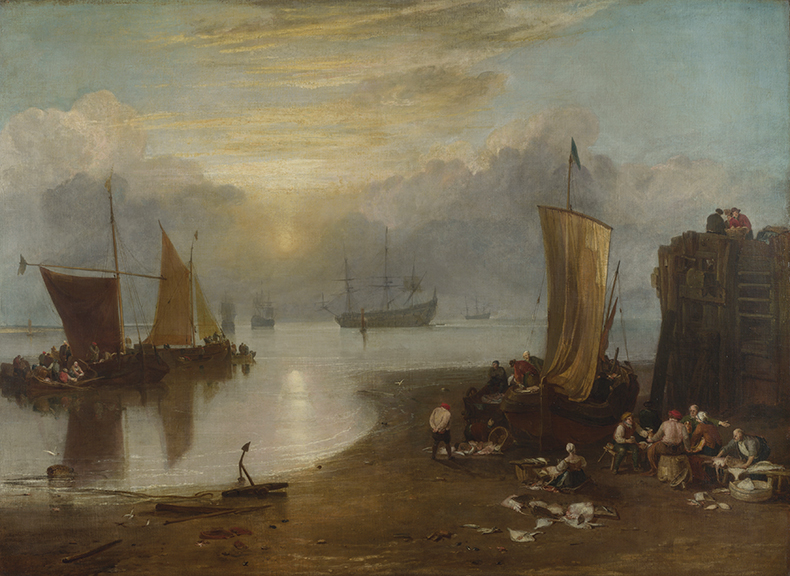
Angerstein’s most significant effect on British art was more oblique. Among the early visitors to Pall Mall was a young J.M.W. Turner, who had been wandering the gallery for some time by himself before Angerstein stumbled upon him in front of ‘the Sea Port by Claude’. On meeting the collector, George Jones recalled, ‘Turner was awkward, agitated, and burst into tears,’ and when pressed ‘said passionately, [that he was crying] “Because I shall never be able to paint any thing like that picture”.’
Angerstein must have been struck by this encounter, since he subsequently purchased one of Turner’s early watercolours of Caernarvon Castle, among the painter’s most obviously Claude-inspired productions. Nevertheless, it was Leicester, not Angerstein, who patronised Turner, and it was Leicester who purchased the later oil painting of the Sun Rising through Vapour (before 1807), in which Claude’s yellow sunlight is filtered through grey clouds on to Dutch boats. Sun Rising through Vapour did, however, still come to Trafalgar Square. Turner bought it back after Leicester’s death and bequeathed it to the nation in 1829 – when the National Gallery was still at Pall Mall – on condition that it should hang next to Angerstein’s ‘Bouillon Claudes’. With this bequest, Turner asserted his artistic debt to Claude and called attention to the Angerstein collection as a resource. Its contents may not have been ‘national’ in West’s sense, but it was distinctively a product of 18th-century Britain – and ultimately the source for some of the nation’s best-loved pictures.
From the May 2024 issue of Apollo. Preview and subscribe here.
